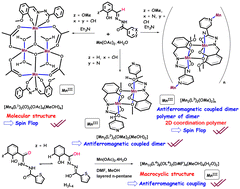Assembly of MnIII ions into di-, tetra-, deca-nuclear coordination complexes, zero- to three-dimensional molecular frameworks: molecular spin flop to and short-range bulk magnetic spin flop ordering†
Abstract
Octahedral MnIII ions possess significant magnetic anisotropy due to second-order orbital contribution combined with Jahn–Teller distortion. This study reports the influence of O2N/O3N-donor ligands (H2L1, H2L2, H2L3, and H3L4) towards the coordination compound structures and their reaction with Mn(OAc)2·4H2O, leading to the isolation of complexes with different nuclearities, such as four MnIII ions containing [MnIII4(μ3-O)2(L1)2(OAc)4(HOMe)4] (1), dimeric [MnIII2(L2)2(μ-OMe)2(HOMe)2] (2), 2D multinuclear coordination polymer [MnIII(L3)(OMe)]n (3), and a decanuclear crown-like complex [Mn10(L4)10(L4O)2(DMF)4(MeOH)4(H2O)2] (4), respectively. Complexes 1 and 2 exist in tetrameric and dimeric forms in the crystal lattice with tetra and binuclear MnIIIO cores, respectively, while 3 forms a 2D polymeric network. Complex 4 reveals a macrocyclic crown-like topology. The temperature-dependent magnetic susceptibilities have been investigated for these complexes in the temperature range of 1.8–300 K under an applied dc magnetic field of 1000 Oe. The MnIII ions of all complexes are antiferromagnetically coupled. Tetranuclear complex 1 shows spin flop type behavior, which purely arises from its molecular origin above a critical dc field of 32 000 Oe at low temperature due to some extent of spin frustration in the MnIII4O6 core with two sets of orthogonal Jahn-Teller axes. The 2D MnIII-polymer 3 displays conventional spin flop due to bulk magnetic ordering below 11 K. The macrocyclic crown-like complex 4 exhibits strong antiferromagnetic coupling between the MnIII-ions. In addition, ab initio calculations were performed to prove the spin flop behavior in 1. The spin–flop type behavior in 1 and 3 was confirmed by field-dependent heat capacity measurements. The sigmoidal shape of the M vs. H plot of 1 was also further supported by ab initio calculations.



 Please wait while we load your content...
Please wait while we load your content...